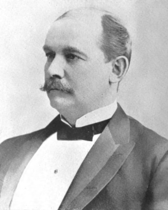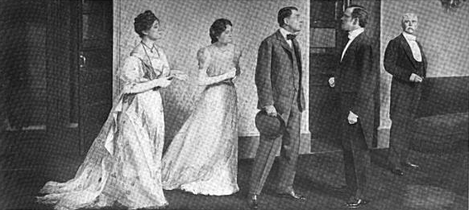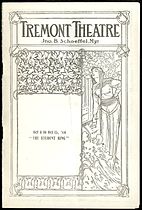
Henry Eugene Abbey was an American theatre manager and producer.
Joseph Stevens Jones was an American actor, playwright, theater manager, and surgeon. He wrote at least 150 plays that were mostly produced at theaters in Boston, Massachusetts.

Three New York City playhouses named Wallack's Theatre played an important part in the history of American theater as the successive homes of the stock company managed by actors James W. Wallack and his son, Lester Wallack. During its 35-year lifetime, from 1852 to 1887, that company developed and held a reputation as the best theater company in the country.

The Shubert Theatre is a theatre in Boston, Massachusetts, at 263–265 Tremont Street in the Boston Theater District. The building has been listed on the National Register of Historic Places since 1980.
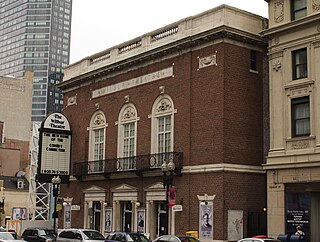
The Wilbur Theatre is a historic performing arts theater at 244–250 Tremont Street in Boston, Massachusetts. The Wilbur Theatre originally opened in 1914, but underwent renovations in 2008. The Wilbur Theatre sits in the heart of Boston's historic theater district and is known for hosting live comedy and music.

The Boston Museum (1841–1903), also called the Boston Museum and Gallery of Fine Arts, was a theatre, wax museum, natural history museum, zoo, and art museum in 19th-century Boston, Massachusetts. Moses Kimball established the enterprise in 1841.
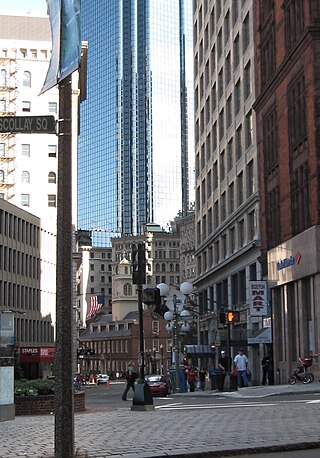
Court Street is located in the Financial District of Boston, Massachusetts. Prior to 1788, it was called Prison Lane (1634–1708) and then Queen Street (1708–1788). In the 19th century it extended beyond its current length, to Bowdoin Square. In the 1960s most of Court Street was demolished to make way for the construction of Government Center. The remaining street extends a few blocks, near the Old State House on State Street.
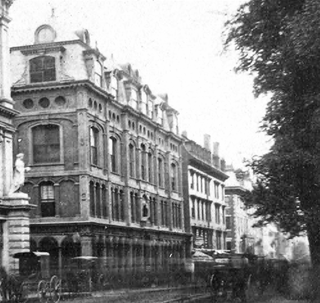
The Studio Building (1861–1906) on Tremont Street in Boston, Massachusetts, housed artists' studios, theater companies and other businesses in the 19th century. It "held the true Bohemia of Boston, where artists and literati delighted to gather." Among the tenants were portraitist E.T. Billings, architect George Snell, sculptor Martin Milmore, artists William Morris Hunt, William Rimmer, Edward Mitchell Bannister, Phoebe Jenks; gallerist Seth Morton Vose, and many others.

Tremont Row (1830s-1920s) in Boston, Massachusetts, was a short street that flourished in the 19th and early-20th centuries. It was located near the intersection of Court, Tremont, and Cambridge streets, in today's Government Center area. It existed until the 1920s, when it became known as Scollay Square. In 1859 the Barre Gazette newspaper described Tremont Row as "the great Dry Goods Street of Boston."

The Park Theatre (est.1879) was a playhouse in Boston, Massachusetts, in the late 19th and early 20th centuries. It later became the State cinema. Located on Washington Street, near Boylston Street, the building existed until 1990.

The Columbia Theatre or Loew's New Columbia Theatre in Boston, Massachusetts, was a playhouse and cinema located in the South End at No. 978 Washington Street. Charles Frohman, Isaac Baker Rich and William Harris oversaw the theatre until 1895. Owners included J.J. Grace of New York and Loews. Staff included Harry Farren, Saul Hamilburg and Philip Shea. The Columbia existed until its demolition in 1957.

B.F. Keith's Theatre (1894–1928) in Boston, Massachusetts, was a vaudeville playhouse run by B.F. Keith. It sat across from Boston Common in the city's theatre district, with an entrance on Tremont Street and another on Washington Street. Personnel included Keith, E.F. Albee and H.E. Gustin. Virgilio Tojetti painted some of the interior decorations. In 1939, the theater was converted to a movie theater named the Normandie.

Chickering Hall (1901–1912) was an auditorium in Boston, Massachusetts, located on Huntington Avenue in the Back Bay. It stood adjacent to Horticultural Hall. Tenants included the Emerson College of Oratory and D.M. Shooshan's "Ladies' and Gents' Cafe." In 1912 it became the St. James Theatre, and later the Uptown Theatre. The building existed until 1963, when it was demolished.
The Plymouth Theatre (1911–1957) of Boston, Massachusetts, was located on Stuart Street in today's Boston Theater District. Architect Clarence Blackall designed the building for Liebler & Co. Performers included Henry Jewett, Bill "Bojangles" Robinson, 8-year-old Sammy Davis Jr., and Bette Davis. In October 1911, the touring Abbey Theatre presented Synge's Playboy of the Western World at the Plymouth; in the audience were W. B. Yeats, Isabella Stewart Gardner and Rose Fitzgerald Kennedy.
The Palace Theatre (ca.1891-1931) of Boston, Massachusetts, United States, was a variety theatre on Court Street in the late 19th and early 20th centuries. Acts which performed there included Rose Hill Folly Co., Clifford & Dixon, Murry & Murry, Behler & Stone, and the Adamless Eden Burlesquers. It also showed photo-plays such as The Exploits of Elaine, The Master Key, and "Charles Chaplin comedies." Among its managers and proprietors were William Austin, F. J. Pilling, George Milbank, and Dunn & Waldron. The Palace occupied the building of the former Nickelodeon. It existed until 1931, when it was demolished.
The National Theatre (1911-1978) of Boston, Massachusetts, was a 3,500-seat multipurpose auditorium on Tremont Street in the South End. It functioned as a cinema, lecture hall, and stage. Performers included Jehovah's Witness founder Joseph F. Rutherford and "big-name entertainers like Duke Ellington and Ray Bolger." Movie screenings included The Battle of Gettysburg in 1913. The English High School held graduation exercises in the National. Around 1919 it was known as the "Waldorf Theater." In 1992, it was purchased by Philip Smith.
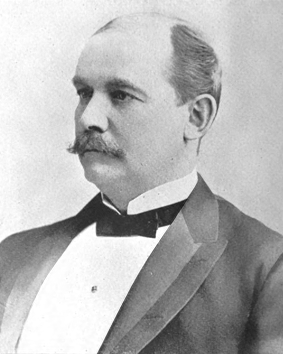
Abbey, Schoeffel and Grau, originally Abbey and Schoeffel, was an American theatre management and production firm. The firm was established in 1876 when a partnership was formed between Henry Abbey and John Schoeffel. Fellow theatre manager and producer Maurice Grau began collaborating with the pair as early as 1880, but did not formally join the firm until 1887 when it became Abbey, Schoeffel and Grau. They managed and ran a number of theatres in New York and Boston, including the Metropolitan Opera House. Abbey was the sole manger and lessee of the Metropolitan Opera during its first season in 1883-4 with Schoeffel uninvolved with the Met at this time. Grau was hired by Abbey to serve as the Met's unofficial business manger during its first season, but did not have a formal title on the Met's staff. Later, Abbey, Schoeffel and Grau were the official co-managers of the Met from 1891 until 1896 when Abbey died. The firm dissolved at the conclusion of the Met's 1896-1897 season, and Grau became the sole manager of the Metropolitan Opera from 1896-1903.

John Baptist Schoeffel, was an American theatre manager and producer, and hotel owner. With Henry E. Abbey he co-founded the theatre management and production firm Abbey and Schoeffel in 1876. Together they managed the Academy of Music in Buffalo, New York and Abbey's Park Theatre in Manhattan until both were destroyed by fire in 1882. They also presented European theatrical stars in tours of the United States, including Henry Irving and Ellen Terry.
Abbey's Park Theatre or Abbey's New Park Theatre was a playhouse at 932 Broadway and 22nd Street in what is now the Flatiron District of Manhattan in New York City. It opened as the New Park Theatre in 1874, and was in use until 1882 when it burned down and was never rebuilt as a theatre.

Maurice Hermann Grau was an Austrian-born American impressario, opera director, and theatre manager and producer. The Americana: A Universal Reference Library stated that "from 1872 until 1903 [Grau] was the most prominent operatic manager in America". He was a named partner in the US theatre management and production firm Abbey, Schoeffel and Grau which managed numerous theaters in Boston and New York City, including the Metropolitan Opera House. As part of this firm Grau co-managed the Metropolitan Opera from 1891 until Abbey's death in 1896 when he took over sole management of the Met. He remained the manager of the Met until 1903 when he retired. He was also concurrently the manager of the Royal Opera House in London from 1897-1900.




